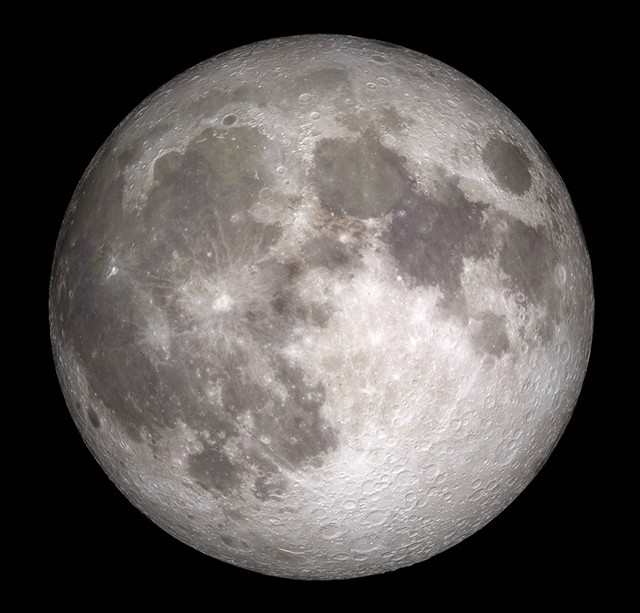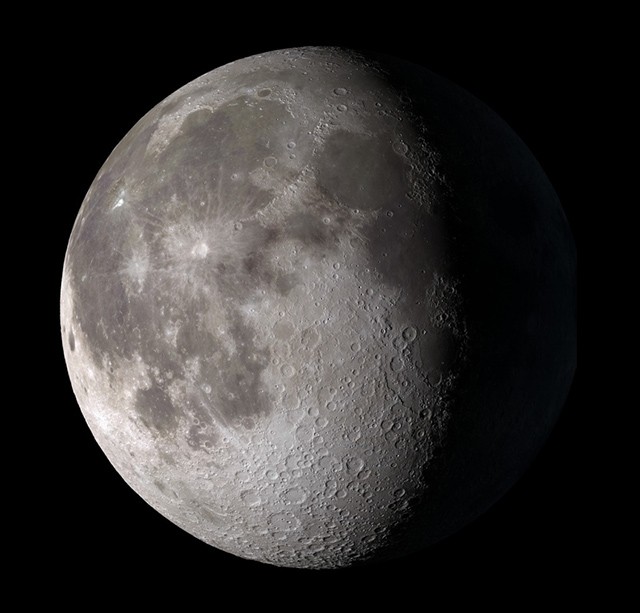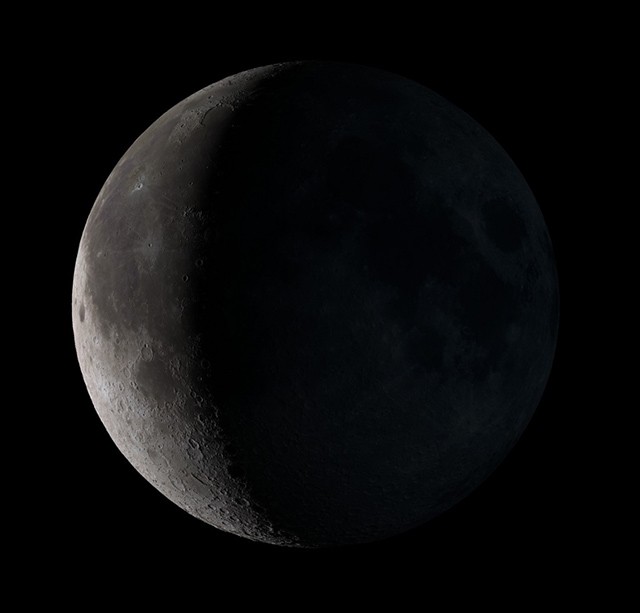Why Does The Moon Have Phases? This is a common question explored at WHY.EDU.VN, and understanding the lunar phases is key to unlocking the mysteries of our celestial neighbor and its monthly cycle. Discover the secrets behind the moon’s changing appearance, lunar cycle, and explore related concepts like tidal locking and earthshine.
1. Unveiling Lunar Phases: Why the Moon Changes Shape
The moon, Earth’s celestial companion, is a constant presence in our night sky. However, its appearance isn’t always the same. The moon goes through a series of distinct shapes, known as phases. But why does the moon have phases? The answer lies in the interplay of the moon’s orbit around Earth, its synchronous rotation, and the sunlight it reflects.
1.1. The Sun’s Role in Lunar Illumination
Unlike the sun, the moon doesn’t produce its own light. Instead, it reflects sunlight. At any given time, half of the moon is illuminated by the sun, while the other half is in darkness. This illuminated portion is what we see from Earth.
1.2. The Moon’s Orbit and Changing Perspective
As the moon orbits Earth, the amount of the illuminated surface we see changes. This is because our viewing angle shifts, revealing different portions of the moon’s sunlit side. These changing perspectives create the lunar phases.
1.3. Synchronous Rotation: One Face to Earth
The moon is tidally locked with Earth, meaning it rotates on its axis at the same rate that it orbits our planet. This synchronous rotation causes the moon to always show the same face to Earth. However, due to libration, we can see slightly more than half of the moon’s surface over time.
2. The Eight Phases of the Moon: A Lunar Cycle Explained
The lunar cycle, from new moon to new moon, takes approximately 29.5 days. This cycle is divided into eight distinct phases, each with its unique characteristics.
2.1. New Moon: The Invisible Phase
During the new moon phase, the moon is between Earth and the sun. The illuminated side of the moon faces away from Earth, making it appear dark and invisible to us. The new moon rises and sets with the sun, appearing in the sky during the daytime.
2.2. Waxing Crescent: A Sliver of Light
As the moon moves along its orbit, a sliver of the illuminated side becomes visible from Earth. This marks the waxing crescent phase. “Waxing” means growing or increasing. The waxing crescent moon rises a little later each day.
2.3. First Quarter: Half Illuminated
At the first quarter phase, the moon is a quarter of the way through its orbit. We see half of the illuminated side, appearing as a half-moon. The first quarter moon rises around noon and sets around midnight.
2.4. Waxing Gibbous: More Than Half
During the waxing gibbous phase, more than half of the moon’s dayside is visible. The moon appears brighter as more of the illuminated surface faces Earth.
2.5. Full Moon: The Brightest Phase
The full moon occurs when Earth is between the sun and the moon. The entire illuminated side of the moon faces Earth, making it appear as a bright, full circle. The full moon rises around sunset and sets around sunrise.
2.6. Waning Gibbous: Shrinking Illumination
As the moon continues its orbit, the illuminated portion starts to decrease. This marks the waning gibbous phase. “Waning” means shrinking or decreasing. The moon rises later and later each night.
2.7. Third Quarter: The Other Half
At the third quarter phase, also known as the last quarter, we see half of the illuminated side again, but the opposite half compared to the first quarter. The third quarter moon rises around midnight and sets around noon.
2.8. Waning Crescent: A Thin Curve
The final phase before the new moon is the waning crescent. Only a thin curve of the moon’s dayside is visible from Earth.
3. Delving Deeper: Exploring Related Lunar Phenomena
Understanding why the moon has phases is just the beginning. Several fascinating phenomena are related to the moon’s orbit and its relationship with Earth.
3.1. Earthshine: Light from Our Planet
During the crescent phases, you might notice a faint glow on the darkened portion of the moon. This is called earthshine. It’s sunlight reflecting off Earth’s surface and illuminating the moon.
3.2. Daytime Moons: A Pale Presence
While we often associate the moon with the night sky, it can also be visible during the day. The best time to spot a daytime moon is during the first and last quarter phases.
3.3. Lunar Libration: Peeking Around the Corner
Although the moon is tidally locked, we can actually see slightly more than half of its surface over time. This is due to a phenomenon called libration, which involves a slight twisting, nodding, and rolling motion of the moon.
3.4. Tidal Locking: The Moon’s Constant Face
Tidal locking is the reason why we only ever see one side of the moon. The moon’s rotation period is equal to its orbital period around Earth, resulting in the same face always pointing towards us.
4. Lunar Eclipses and Solar Eclipses: Shadows in Space
Lunar phases are intimately connected with eclipses, those spectacular events when one celestial body blocks the light from another. Lunar eclipses and solar eclipses offer stunning visual demonstrations of the alignment between the Sun, Earth, and Moon.
4.1. Lunar Eclipses: Earth’s Shadow on the Moon
A lunar eclipse occurs when the Earth passes between the Sun and the Moon, casting its shadow on the Moon. This can only happen during the full moon phase. There are three types of lunar eclipses:
- Total Lunar Eclipse: The entire Moon passes through the Earth’s umbra (the darkest part of the shadow), turning it a reddish hue. This is often called a “blood moon”.
- Partial Lunar Eclipse: Only a portion of the Moon passes through the Earth’s umbra.
- Penumbral Lunar Eclipse: The Moon passes through the Earth’s penumbra (the outer, lighter part of the shadow), resulting in a subtle dimming of the Moon’s surface.
4.2. Solar Eclipses: The Moon Blocks the Sun
A solar eclipse occurs when the Moon passes between the Sun and the Earth, blocking the Sun’s light. This can only happen during the new moon phase. There are also different types of solar eclipses:
- Total Solar Eclipse: The Moon completely covers the Sun, turning day into twilight. This is a rare and awe-inspiring event.
- Partial Solar Eclipse: The Moon only partially covers the Sun.
- Annular Solar Eclipse: The Moon is too far from the Earth to completely cover the Sun, leaving a bright ring (or annulus) of sunlight visible around the Moon.
- Hybrid Solar Eclipse: This is a rare type of eclipse that appears as a total eclipse at some locations on Earth and an annular eclipse at others.
Understanding the conditions required for both lunar and solar eclipses requires knowledge of the Moon’s orbit, the tilt of the Earth, and the ever-changing distances between these celestial bodies.
5. The Moon’s Influence: Tides and More
Beyond its visual spectacle, the Moon exerts a significant influence on Earth, most notably through the tides. Understanding these effects can deepen our appreciation of the Moon’s role in our planet’s ecosystem.
5.1. Tides: The Moon’s Gravitational Pull
The Moon’s gravitational pull is the primary cause of tides on Earth. The Moon’s gravity pulls on the side of Earth closest to it, creating a bulge of water. A similar bulge occurs on the opposite side of the Earth due to inertia. As the Earth rotates, different locations pass through these bulges, experiencing high tides.
- Spring Tides: These occur during the new moon and full moon phases when the Sun, Earth, and Moon are aligned. The combined gravitational pull of the Sun and Moon results in higher high tides and lower low tides.
- Neap Tides: These occur during the first quarter and third quarter moon phases when the Sun and Moon are at right angles to each other relative to Earth. The gravitational forces partially cancel each other out, resulting in less extreme tides.
5.2. Other Influences: Myth and Science
The Moon has long been associated with various aspects of human life, from agriculture to behavior. While many of these beliefs are rooted in folklore, scientific research continues to explore the Moon’s potential influence on:
- Plant Growth: Some studies suggest that the Moon’s phases can affect plant growth, although the evidence is not conclusive.
- Animal Behavior: Certain animals, such as nocturnal creatures, may exhibit behaviors influenced by the lunar cycle.
- Human Sleep: There is ongoing research into the potential correlation between lunar phases and human sleep patterns.
6. Observing the Moon: Tips and Tools
Observing the Moon can be a rewarding experience, connecting us to the cosmos in a tangible way. Whether you’re a beginner or an experienced stargazer, there are tools and tips to enhance your lunar observations.
6.1. Naked-Eye Observing: A Simple Start
You don’t need any special equipment to observe the Moon’s phases. Simply look up at the night sky and observe the changing shape of the Moon over the course of a month. A pair of binoculars can enhance your view, revealing more details on the lunar surface.
6.2. Telescopes: Unveiling Lunar Details
A telescope can reveal craters, mountains, and other features on the Moon’s surface. Choose a telescope with a suitable aperture (the diameter of the main lens or mirror) for lunar observing.
6.3. Mobile Apps and Websites: Lunar Guides at Your Fingertips
Numerous mobile apps and websites provide information about the Moon’s phases, rise and set times, and other useful data. These tools can help you plan your lunar observing sessions.
6.4. Moon Maps and Atlases: Navigating the Lunar Surface
Moon maps and atlases can help you identify specific features on the lunar surface, such as craters, maria (dark plains), and mountain ranges.
7. The Moon in Culture and History
The Moon has held a prominent place in human culture and history for millennia. From ancient myths and legends to modern-day space exploration, the Moon has inspired awe, wonder, and a thirst for knowledge.
7.1. Mythology and Folklore: Lunar Deities and Legends
In many ancient cultures, the Moon was personified as a deity, often associated with femininity, cycles, and the night. Lunar goddesses like Luna (Roman), Selene (Greek), and Chang’e (Chinese) played significant roles in mythology and religious beliefs.
7.2. Lunar Calendars: Measuring Time by the Moon
Many ancient cultures used lunar calendars, which were based on the cycles of the Moon. These calendars were essential for tracking seasons, agricultural cycles, and religious observances.
7.3. Space Exploration: Reaching for the Moon
The 20th century witnessed humanity’s greatest achievement in lunar exploration: the Apollo missions. On July 20, 1969, Neil Armstrong became the first human to walk on the Moon, marking a pivotal moment in history.
7.4. Future Missions: Returning to the Moon
Today, there is renewed interest in lunar exploration, with plans for future missions to the Moon, including the Artemis program, which aims to establish a sustainable human presence on the lunar surface.
8. Understanding the Dark Side of the Moon: Myths and Realities
The “dark side of the Moon” is a common phrase, but it’s often misunderstood. Understanding the reality behind this term can clear up misconceptions and deepen our knowledge of the Moon.
8.1. Far Side vs. Dark Side: A Key Distinction
The far side of the Moon is the hemisphere that always faces away from Earth. It’s important to distinguish this from the “dark side,” which is the portion of the Moon that is not illuminated by the Sun at any given time.
8.2. The Far Side is Not Always Dark: Illumination Varies
The far side of the Moon experiences day and night cycles just like the near side. When it’s a new moon on Earth, the far side is fully illuminated.
8.3. Exploring the Far Side: Missions and Discoveries
Several missions have explored the far side of the Moon, including the Chinese Chang’e 4 mission, which landed the first spacecraft on the far side in 2019. These missions have revealed unique geological features and provided valuable scientific data.
9. Lunar Occultations: When the Moon Covers Stars and Planets
Lunar occultations occur when the Moon passes in front of a star or planet, briefly blocking it from view. These events can be a fascinating way to observe the Moon’s motion and its interactions with other celestial objects.
9.1. Predicting Occultations: Tools and Resources
Astronomical software and websites can predict lunar occultations for your location. These predictions include the time of the occultation, the star or planet involved, and the duration of the event.
9.2. Observing Occultations: A Unique Experience
Observing a lunar occultation can be a rewarding experience, especially when using a telescope. The sudden disappearance and reappearance of a star or planet as the Moon passes in front of it is a captivating sight.
10. Frequently Asked Questions About Moon Phases
Here are some frequently asked questions about moon phases to further enhance your understanding:
| Question | Answer |
|---|---|
| What causes the phases of the moon? | The phases are caused by the changing angles at which we see the moon’s illuminated surface as it orbits Earth. |
| How long does it take for the moon to orbit Earth? | It takes approximately 27.3 days for the moon to complete one orbit around Earth (sidereal period). The synodic period (new moon to new moon) is about 29.5 days. |
| What is the difference between waxing and waning? | Waxing means the illuminated portion of the moon is increasing, while waning means it is decreasing. |
| What is a blue moon? | A blue moon is either the second full moon in a calendar month or the third full moon in a season with four full moons. |
| Why do we only see one side of the moon? | The moon is tidally locked with Earth, meaning its rotation period is equal to its orbital period. |
| What is earthshine? | Earthshine is sunlight reflecting off Earth’s surface and illuminating the darkened portion of the moon. |
| Can you see the moon during the day? | Yes, the moon can be visible during the day, especially during the first and third quarter phases. |
| What is the far side of the moon? | The far side is the hemisphere that always faces away from Earth. |
| What is a supermoon? | A supermoon occurs when the full moon coincides with the moon’s closest approach to Earth in its orbit. |
| What is a micro moon? | A micro moon occurs when the full moon coincides with the moon’s farthest point from Earth in its orbit. |




Understanding why the moon has phases opens a window into the fascinating mechanics of our solar system. The interplay of sunlight, the moon’s orbit, and its synchronous rotation creates the beautiful cycle of lunar phases we observe from Earth. From ancient myths to modern-day space exploration, the moon continues to captivate our imagination and inspire us to explore the cosmos.
Want to delve deeper into the mysteries of space and astronomy? At WHY.EDU.VN, we’re dedicated to providing clear, reliable answers to all your questions about the universe. Whether you’re curious about black holes, distant galaxies, or the possibility of life beyond Earth, our team of experts is here to guide you.
Do you have a burning question about why the moon has phases or any other scientific topic? Visit WHY.EDU.VN at 101 Curiosity Lane, Answer Town, CA 90210, United States, or reach out to us on Whatsapp at +1 (213) 555-0101. Let WHY.EDU.VN be your trusted source for knowledge and exploration. Ask your question today and unlock the wonders of the universe! Website: why.edu.vn
